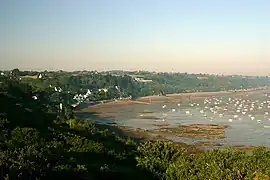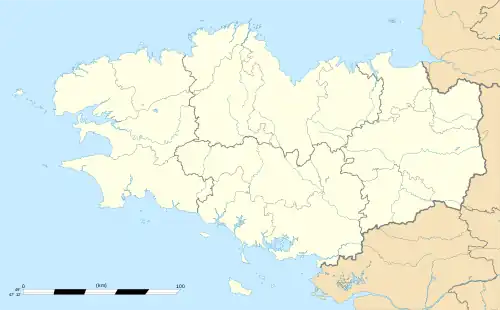Plouézec
Plouézec (French pronunciation: [pluezɛk]; Breton: Ploueg-ar-Mor) is a commune in the Côtes-d'Armor department in Brittany in northwestern France.
Plouézec
Ploueg-ar-Mor | |
|---|---|
 View over Port Lazo | |
.svg.png.webp) Coat of arms | |
Location of Plouézec | |
 Plouézec  Plouézec | |
| Coordinates: 48°44′56″N 2°59′02″W | |
| Country | France |
| Region | Brittany |
| Department | Côtes-d'Armor |
| Arrondissement | Guingamp |
| Canton | Paimpol |
| Intercommunality | Guingamp-Paimpol Agglomération |
| Government | |
| • Mayor (2020–2026) | Jacques Mangold[1] |
| Area 1 | 27.87 km2 (10.76 sq mi) |
| Population | 3,126 |
| • Density | 110/km2 (290/sq mi) |
| Time zone | UTC+01:00 (CET) |
| • Summer (DST) | UTC+02:00 (CEST) |
| INSEE/Postal code | 22214 /22470 |
| Elevation | 0–106 m (0–348 ft) |
| 1 French Land Register data, which excludes lakes, ponds, glaciers > 1 km2 (0.386 sq mi or 247 acres) and river estuaries. | |
It has 17 km of rugged coastline that makes it a tourist destination all year round, with beaches such as Bréhec and Pors Pin.
Plouézec is twinned with the Irish town of Ballinamore and the twinning committee hosts a Fest Noz festival every August around the Moulin de Craca which regularly draws thousands of visitors. There is traditional Irish and Breton music, as well as food and drink available. Especially popular is the famous moules-frites, which is a dish of mussels and French fries.
It has been strongly influenced by the sea and local people often refer to themselves as enfants de la mer (children of the sea). Water-based sports such as fishing, sailing, and swimming are very popular and are practised by locals and tourists alike.
Population
Inhabitants of Plouézec are called plouézécains in French.
| Year | Pop. | ±% p.a. |
|---|---|---|
| 1968 | 3,481 | — |
| 1975 | 3,399 | −0.34% |
| 1982 | 3,124 | −1.20% |
| 1990 | 3,089 | −0.14% |
| 1999 | 3,181 | +0.33% |
| 2007 | 3,322 | +0.54% |
| 2012 | 3,296 | −0.16% |
| 2017 | 3,182 | −0.70% |
| Source: INSEE[3] | ||
Breton language
The municipality launched a linguistic plan through Ya d'ar brezhoneg on November 14, 2008.
References
- "Répertoire national des élus: les maires". data.gouv.fr, Plateforme ouverte des données publiques françaises (in French). 2 December 2020.
- "Populations légales 2020". The National Institute of Statistics and Economic Studies. 29 December 2022.
- Population en historique depuis 1968, INSEE
External links
- City council website
- History and sights of Plouézec (in French)
- Base Mérimée: Search for heritage in the commune, Ministère français de la Culture. (in French)